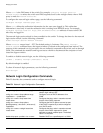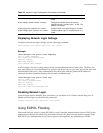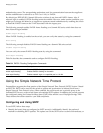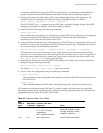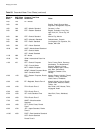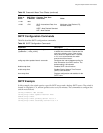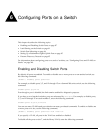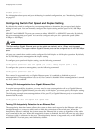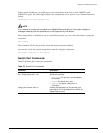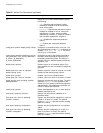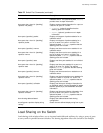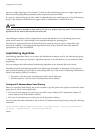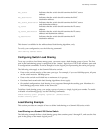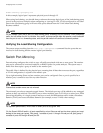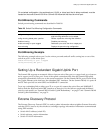
88 Summit 200 Series Switch Installation and User Guide
Configuring Ports on a Switch
disable ports 7:*
For information about ports and port addressing in stacked configurations, see “Introducing Stacking”
on page 237.
Configuring Switch Port Speed and Duplex Setting
By default, the switch is configured to use autonegotiation to determine the port speed and duplex
setting for each port. You can manually configure the duplex setting and the speed of 10/100 Mbps
ports.
10BASE-T and 100BASE-TX ports can connect to either 10BASE-T or 100BASE-T networks. By default,
the ports autonegotiate port speed. You can also configure each port for a particular speed (either
10 Mbps or 100 Mbps).
NOTE
The fiber-medium Gigabit Ethernet ports on the switch are statically set to 1 Gbps, and the speed
cannot be modified. The copper-medium Gigabit Ethernet ports can be configured as 10/100/1000 Mbps
ports.
All ports on a stand-alone switch can be configured for half-duplex or full-duplex operation. By default,
the 10/100 Mbps ports autonegotiate the duplex setting.
To configure port speed and duplex setting, use the following command:
config ports <portlist> auto off {speed [10 | 100 | 1000]} duplex [half | full]
To configure the system to autonegotiate, use the following command:
config ports <portlist> auto on
Flow control is supported only on Gigabit Ethernet ports. It is enabled or disabled as part of
autonegotiation. If autonegotiation is set to off, flow control is disabled. When autonegotiation is turned
on, flow control is enabled.
Turning Off Autonegotiation for a Gigabit Ethernet Port
In certain interoperability situations, you may need to turn autonegotiation off on a Gigabit Ethernet
port. Even though a Gigabit Ethernet port runs only at full duplex, you must specify the duplex setting.
The following example turns autonegotiation off for port 25 (a Gigabit Ethernet port) on a stand-alone
Summit 200-24 switch:
config ports 25 auto off duplex full speed 1000
Turning Off Autopolarity Detection for an Ethernet Port
The autopolarity detection feature allows the system to detect and respond to the Ethernet cable type
(straight-through vs. crossover cable) used to make the connection to the switch port. When the
autopolarity feature is enabled, the system causes the Ethernet link to come up regardless of the cable
type connected to the port. When the autopolarity feature is disabled, the link will come up only when
a crossover cable is connected to the port. The autopolarity feature is supported only on the 10BASE-T
and 100BASE-TX switch ports, and enabled by default.



